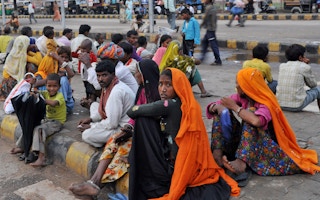One year on, what progress has been made in India to implement the 17 Sustainable Development Goals (SDGs)?
We have been talking to key stakeholders to get an understanding of what the government has done in the first year, what it has not done, and where there is room for improvement. India’s growing economy gives it the potential to show real leadership on poverty reduction and environmental targets – but will it deliver?
The Government of India has entrusted a government think tank, NITI Aayog, with coordinating the 2030 Agenda in India, with the Ministry of Statistics and Programme Implementation (MoSPI) designated the role of defining indicators and locating them in the national context. NITI Aayog has carried out a draft mapping of goals and targets against existing schemes, and MoSPI is working with ministries to develop indicators.
There is also action at the state level, with states asked to put forward their plans for implementing the SDGs to NITI Aayog. The state government of Assam has been the first to do this, producing a Vision Document 2030, looking at the SDGs in relation to its long-term development strategy. This includes a proposal to introduce an SDG charter for each government ministry.
In parallel to the design for SDGs implementation in India, NITI Aayog is also leading the formation of a 15-year development plan for India. The timeline of the 15-year plan is aligned with the SDGs timeline but it is yet to be seen how much the two processes will be integrated.
“
The SDGs represent a great opportunity for Indian stakeholders – the government, businesses, civil society and citizens – to identify and address key challenges, and to align solving these problems with economic growth.
Some pertinent questions
Our research with business, government officials and civil society raised a number of questions about India’s strategy in relation to the SDGs. NITI Aayog has set the ball rolling and achieved some momentum, but as NITI Aayog is an institute at its nascent stage of formation, the processes of how NITI will coordinate with the states and how activities will be conducted jointly are currently ambiguous.
It is also not clear who will be responsible for representing India at the United Nations. Should a representative from NITI Aayog be accountable, given that NITI is a think tank of the government and therefore cannot be a representative the government? Or should this be a role for MoSPI?
There are also questions as to how the individual states will interact with each other through NITI Aayog. Will there be opportunities for building consensus on the approaches used, or changes to vet development plans? Will there be shared learning? And how will coherence between the states be achieved?
Some relevant concerns
From the evidence so far, it seems that very little effort has been made to consult with citizens, civil society or business on how to implement the SDGs in India.
The local government (panchayats), and citizens need to be informed of the SDGs and in the process, explore the value in working towards achieving it. There has been very little effort from the governments in this area.
Many state governments are themselves currently in the process of trying to understand the SDGs and their relevance in the Indian context. Having said that, non-inclusion of citizen bodies from the very initiation of SDGs may in future become complete alienation of the citizens from the concept of SDGs.
The current approach of India seems to miss the holistic nature of sustainable development, allowing the goals and targets to be divided up between different ministries and departments without identifying the interlinkages that exist between the different goals, and this risks working in siloes – which is unlikely to deliver.
Of equal concern is the attitude of many ministries who see the SDGs as purely aspirational in nature – and therefore not something that they need to deliver.
Sustainability is not optional icing on the development cake – it requires a new recipe and method.
What is needed now
The SDGs provide a useful advocacy guide for local development issues and civil society must use them to demand a more holistic approach to the issues citizens face. It is critical that citizen groups and civil society representatives are involved and participate in the formulation of the SDGs plan and the 15-year plan that India is in the process of developing.
Involving citizen groups and civil society ensures more buy-in from different stakeholders but also drives more resources, potential solutions and the collective will of society to achieve the SDGs.
Civil society movements have been wide and diverse in India for more than two decades now, from the JP movement in 1970s which confronted the then government with a mobilised citizenry against misrule, through to the Right to Information movement in late 1990s.
Civil society has also taken the role of research and analysis, implementation and review of government programmes. Large-scale flagship programmes such as the Mahatma Gandhi National Rural Employment Guarantee programme, Self Help Groups, and the Integrated Watershed Development Programme have been implemented due to support from civil society organisations on the ground.
The SDGs represent a great opportunity for Indian stakeholders – the government, businesses, civil society and citizens – to identify and address key challenges, and to align solving these problems with economic growth.
If India can achieve the SDGS, we will all see, feel and live the benefits – and the global community will benefit as well.
Anshul Bhamra and Syed A A Farhan are part of the policy analysis and communications team at Development Alternatives. This post is republished from the IIED blog.











